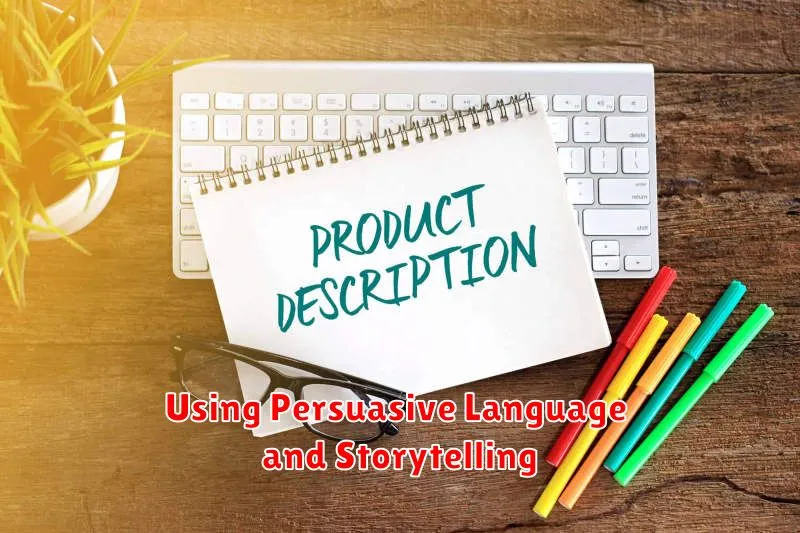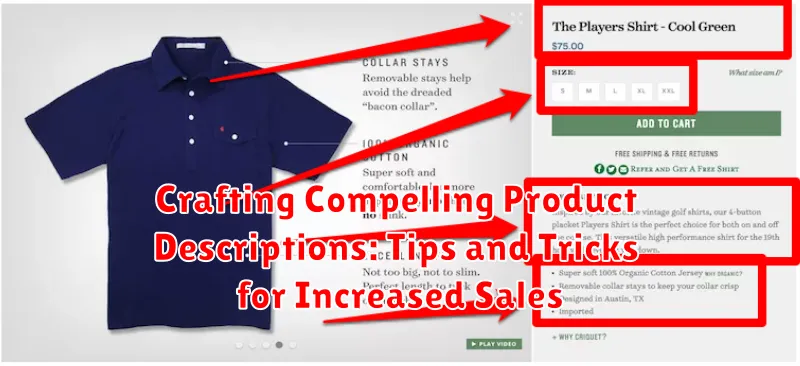In today’s competitive e-commerce landscape, crafting compelling product descriptions is paramount to driving sales and capturing customer attention. A well-written product description goes beyond simply listing features; it tells a story, highlights benefits, and persuades potential buyers that the product is the perfect solution to their needs. This article delves into the art of writing effective product descriptions, offering actionable tips and tricks to elevate your product listings and ultimately, increase sales.
Discover the secrets to transforming mundane product details into captivating narratives that resonate with your target audience. From understanding your ideal customer and utilizing persuasive language to optimizing for search engines and showcasing the unique value proposition of your products, we’ll explore proven strategies to create product descriptions that convert browsers into buyers. Mastering this essential e-commerce skill can significantly impact your bottom line, boosting conversion rates and establishing a stronger brand presence. Learn how to craft compelling product descriptions that sell, using proven tips and tricks for increased sales.
Understanding Your Target Audience and Their Needs
Before crafting a single word of your product description, you must understand your target audience. Knowing their demographics, psychographics, pain points, and motivations is crucial. This understanding allows you to tailor your descriptions directly to their needs and desires, increasing the likelihood of a purchase.
Ask yourself: Who is this product for? What problems does it solve for them? What are their values and priorities? By answering these questions, you can create a customer persona that guides your writing. For example, if your target audience is tech-savvy millennials, your language can reflect their familiarity with technical jargon. Conversely, if you’re targeting senior citizens, simpler language and a focus on ease of use would be more effective.
Research is key. Utilize market research, customer surveys, and social media analytics to gather insights into your target audience. This information will allow you to create highly targeted and effective product descriptions that resonate with your ideal customer.
Highlighting Key Features and Benefits
A compelling product description doesn’t just list features; it translates them into tangible benefits for the customer. Focus on what the product does for the buyer, not just what it is. Clearly articulate how each feature improves their life, solves a problem, or fulfills a need.
Begin by identifying the key features of your product. These are the defining characteristics that set it apart. Then, for each feature, ask yourself: “So what?” What does this feature mean for the customer? The answer to this question is the benefit.
For example, instead of simply stating “This laptop has a 1TB hard drive,” highlight the benefit: “Store thousands of photos and videos with the massive 1TB hard drive.” This approach connects with the customer on a personal level, making the product more desirable.
Using a table can effectively present features and benefits side-by-side:
| Feature | Benefit |
|---|---|
| Lightweight design | Easy portability for travel and commuting |
| Long battery life | Stay productive on the go without needing to recharge frequently |
Using Persuasive Language and Storytelling

Persuasive language is crucial for transforming product descriptions into compelling narratives. Employ power words that evoke emotion and create a sense of urgency or exclusivity. Words like “discover,” “imagine,” “transform,” and “unleash” can resonate deeply with potential buyers.
Storytelling adds a human touch to your descriptions. Weave a narrative around your product, showcasing how it solves a problem or enhances a customer’s life. Instead of simply listing features, describe the experience and benefits they provide. For example, instead of stating “waterproof material,” you could say “Brave any weather with confidence thanks to its durable, waterproof construction.”
Sensory details further enhance the story. Engage the reader’s imagination by appealing to sight, sound, touch, taste, and smell. Describe the vibrant color of a scarf, the rich aroma of coffee beans, or the smooth feel of a luxurious fabric.
Focus on benefits, not just features. Customers buy solutions, not specifications. Highlight how your product makes their lives easier, better, or more enjoyable. Frame features in terms of their positive impact on the user.
Optimizing Product Descriptions for Search Engines (SEO)
Optimizing your product descriptions for search engines is crucial for driving organic traffic and increasing visibility. Keyword research is the foundation of SEO. Identify relevant keywords that potential customers use when searching for products like yours. Integrate these keywords naturally within your product descriptions, avoiding keyword stuffing.
Focus on long-tail keywords which are longer, more specific phrases. These often have lower competition and higher conversion rates. For example, instead of “shoes,” try “women’s running shoes for flat feet.”
Optimize the product title and meta description. The title should be concise and include your primary keyword. The meta description provides a brief summary of the product and should entice users to click through from search results.
Structured data markup helps search engines understand the content on your product pages. Implement schema markup to provide detailed information about your products, such as price, availability, and reviews. This can enhance your visibility in search results and improve click-through rates.
The Importance of High-Quality Product Images
While compelling product descriptions are crucial, high-quality images are equally vital for driving sales. Customers rely heavily on visuals to assess a product’s appearance, features, and overall quality. Images allow potential buyers to visualize owning and using the product, fostering a stronger connection and desire to purchase.
Professional, well-lit photographs showcase the product in its best light, highlighting details and textures that might be missed in a written description. Multiple images from different angles provide a comprehensive view, minimizing uncertainty and building buyer confidence. Consider including close-ups to demonstrate intricate details or unique features.
Consistency in image style and quality across your product catalog creates a cohesive and professional brand image. This consistency reinforces trust and encourages customers to browse more products, potentially leading to increased sales. Invest in professional photography or learn essential photography techniques to ensure your product images accurately represent the quality and value of your offerings.
Showcasing Social Proof and Customer Testimonials
Social proof is a powerful tool for influencing purchasing decisions. Incorporating it into your product descriptions can significantly boost conversions. Highlight positive reviews and testimonials to build trust and credibility.
Feature snippets of customer testimonials directly within the product description. Choose reviews that highlight key benefits or address common concerns. For example, a quote like, “This product solved my long-standing back pain!” can be more impactful than a generic “Great product!” review.
Quantify your social proof whenever possible. Instead of simply saying “popular choice,” state “Chosen by over 10,000 satisfied customers.” This adds weight and validity to your claims.
Consider using star ratings or aggregate review scores. Visual cues like these can quickly communicate product quality and customer satisfaction. Ensure these ratings are genuine and verifiable.
Creating a Sense of Urgency and Scarcity
Urgency and scarcity are powerful psychological triggers that can significantly influence purchasing decisions. By subtly incorporating these elements into your product descriptions, you can encourage customers to act quickly and avoid missing out.
Limited-time offers are a classic way to create urgency. Phrases like “sale ends soon,” “limited-time offer,” or “for a limited time only” can effectively prompt immediate action. Specifying a deadline, such as “Offer expires on [Date],” adds a concrete element to the urgency.
Scarcity tactics focus on the limited availability of a product. Highlighting low stock levels with phrases like “only a few left,” “while supplies last,” or “limited quantities available” can create a sense of exclusivity and desirability. You can also emphasize limited-edition products or special collections to amplify the scarcity effect.
Combining urgency and scarcity can further enhance their impact. For example, you could state “Only 5 left at this price! Sale ends tomorrow.” This approach reinforces the need for immediate action due to both limited stock and a time constraint.
Remember to use these tactics ethically and avoid creating false scarcity. Be truthful about availability and deadlines to maintain customer trust.
A/B Testing Your Product Descriptions for Optimal Performance

A/B testing, also known as split testing, is a crucial step in optimizing your product descriptions. It involves comparing two versions of a product description (version A and version B) to see which performs better.
The process begins by creating two distinct versions of your product description. Change one key element at a time, such as the headline, call to action, or product benefits. Keep everything else consistent to isolate the impact of the change.
Show version A to one half of your audience and version B to the other half. Track key metrics, such as click-through rates, conversion rates, and bounce rates. The version that yields the best results becomes your winning description.
Continuously iterate. After determining a winner, use it as the control and test against a new variation. This ongoing process of testing and refining allows for continuous improvement and helps ensure your product descriptions remain effective in driving sales.

